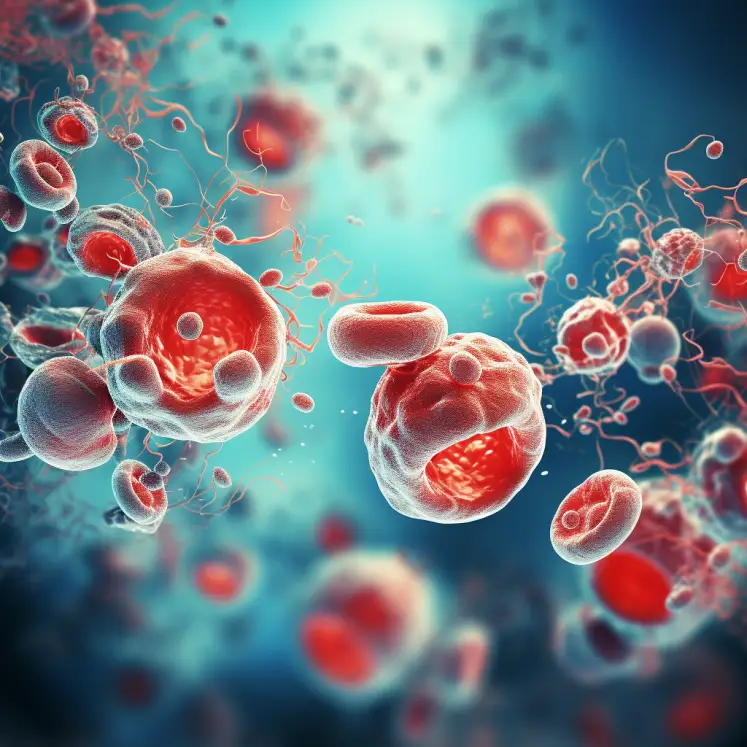Hematopoietic stem cell definition
Hematopoietic stem cells are precursor cells of blood cells. As a result of their maturation and differentiation, they produce all types of blood cells of myeloid (monocytes, macrophages, neutrophils, basophils, eosinophils, erythrocytes, megakaryocytes and platelets, dendritic cells) and lymphoid series (T-lymphocytes, B-lymphocytes, and natural killer cells) that determine immunity, fight infections, carry oxygen, and participate in blood coagulation processes. This is just one of several types of stem cells that can be found in our bodies.
Hematopoietic stem cell function
When hematopoietic stem cells (HSCs) are infused into a patient whose blood formation has been destroyed (as a result of high-dose chemotherapy, for example), they are able to populate the recipient’s bone marrow with their descendants and increase the number of blood cells, thereby restoring blood formation. Hematopoietic stem cell transplantation is based on this ability. Moving through the bloodstream, HSCs gradually populate the bone marrow and begin producing blood cells. These HSC cells are able to speed up the production of billions of new blood cells each day and completely restore the hematopoietic system and immune system, even when transplanted in small quantities. To learn more about different types of stem cells check out our post about multipotent stem cells.
HSCs populations
Stem cell studies prove that there are two populations of progenitor (cells that differentiate into a specific cell type) hematopoietic stem cells: long-term and short-term. Long-term HSC cells are capable of self-renewing; short-term HSCs are not. However, short-term HSCs can differentiate into all types of blood cells.
Where are HSCs found?
Hematopoietic stem cells can be obtained from three sources:
- Bone marrow
- Peripheral blood
- Cord blood
Let’s take a closer look at these three sources.
HSCs from bone marrow
Over a long period of time, bone marrow was the main source of HSC cells (and still widely used in transplantology). HSCs are located in adult bone marrow, including the femur, ribs, sternum mobilization, and other bones. But after the first successful transplantation of cord blood by Professor E. Gluckman (a boy with Fanconi anemia), cord blood took its rightful place in modern transplantology.
Hematopoietic stem cells from cord blood
The concentration of pluripotent hematopoietic stem cells in cord blood is ten times higher than in bone marrow. In addition, this source has several advantages for stem cell therapies:
- Age: Cord blood is collected at the earliest stage of an organism’s life. Umbilical cord blood HSCs are maximally active because they haven’t been exposed to negative effects of the external environment (infectious diseases, unhealthy diet, etc.) For this reason, umbilical cord blood HSC cells are able to create a large cell population in a short time.
- Compatibility: The use of autologous biomaterial (a patient’s own cord blood) guarantees 100% compatibility. Compatibility with brothers and sisters can be up to 25%, and it is also possible to use the cord blood of a child to treat other close relatives. For comparison, the probability of finding a suitable stem cell donor is from 1:1,000 to 1:1,000,000. In many cases, cord blood transplantation is not merely a good alternative to bone marrow transplantation, but the only chance for the patient to survive.
- Stem cell collection and patient recovery: Compared to bone marrow, cord blood stem cell sampling is much easier, and the recovery of neutrophil and platelet count is faster.
- Low risk of rejection: Cord blood transplantation significantly reduces the risks of rejection and the occurrence of graft versus host reaction.
Hematopoietic stem cells from peripheral blood
Compared to bone marrow transplants, a peripheral blood transplant has many advantages:
- Peripheral blood contains more HSCs.
- Myeloid cells and platelets have a faster recovery.
- Cellular immunity is restored faster.
- Mortality rate due to transplantation is much lower.
What diseases can be treated using hematopoietic stem cells?
Already, hematopoietic stem cells show great potential in the treatment of many serious diseases. For example, HSC cells are
- used to treat patients with lymphoproliferative diseases (multiple myeloma, non-Hodgkin’s lymphoma, and Hodgkin’s disease);
- included in the treatment protocols for Parkinson’s disease, Alzheimer’s, Type 1 diabetes, myocardial infarction, and aplastic anemia;
- used in developing experimental approaches to the treatment of kidney and breast cancer, osteoporosis, systemic lupus erythematosus, joint lesions, and bone fractures.
- To learn even more visit our post What Does Stem Cell Therapy Do?
- Learn the difference between Embryonic and Adult Stem Cells.

